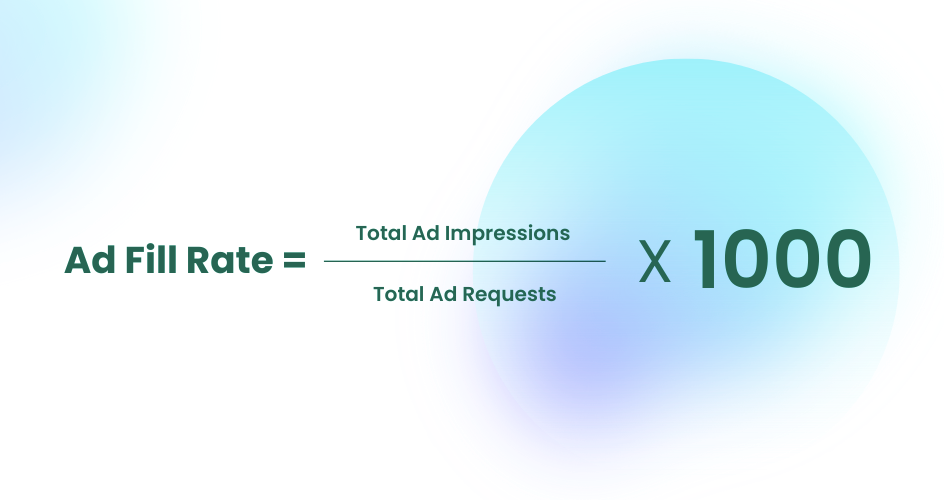
What is Ad Fill Rate and Should You Aim For 100%?
Publishers constantly strive to monetize their content and maximize their revenue streams. The key is to generate revenue from every page view or impression at the most optimal price, which brings us to the concept of fill rate.
What is the fill rate?
Ad fill rate is a crucial metric for publishers that indicates the percentage of ad inventory filled with actual advertisements. It represents the ratio between the number of ads delivered and the number of ads requested by the ad server.
How to calculate the fill rate?
In other words, the fill rate is the percentage of the ad requests filled with an advertisement and not returned blank.
Mathematically, the ad fill rate percentage is calculated using the following formula:
Ad Fill Rate = (Number of Ad Impressions / Number of Ad Requests) x 100%
If for example you send out 2 million ad requests but only receive 1 million impressions in return, your fill rate is calculated ad 50% and you are theoretically leaving 50% of the potential revenue on the table.
Ad Fill Rate = (85 / 100) x 100% = 85%
So, a higher fill rate indicates that a greater proportion of available ad spaces on a website are occupied by ads, leading to improved monetization. Conversely, a lower fill rate suggests that many ad spaces remain vacant or unfilled, negatively impacting revenue generation.
Why the fill rate is not always 100%?
It’s worth noting that while publishers desire all ad requests to be filled with ads, advertisers want their ads to reach the right audience at the right time.
It’s important to note that the ad fill rate can vary depending on various factors, including the publisher’s website or app content, the types of ad formats used, and the performance of the ad network. Therefore, achieving a 100% fill rate consistently is challenging. The advertisers might have no demand or limited budget for a particular audience or GEO or content niche.
How can I increase my ad fill rate?
There are several strategies that publishers can employ to increase their ad fill rates, such as:
- optimizing ad placements;
- utilizing multiple ad networks: Ad Exchange + Header Bidding + Direct Sales
- improving content quality;
- targeting the right audience;
- adjusting ad formats and sizes.
Is it ideal to aim to 100% Fill Rate?
No. Although a 100% fill rate might appear ideal for publishers, it doesn’t necessarily indicate good or bad performance on its own. A 100% fill rate simply means that all ad requests made by the publisher were filled with an ad.
However, it’s equally important to ensure that your effective cost per mille (eCPM) doesn’t decrease. Some publishers compromise their eCPM to achieve a consistently high fill rate, which isn’t commendable.
So, should I aim to high fill rate or high CPM?
Both, and neither of them.
Ideally, publishers should aim for a higher fill rate and a higher CPM (cost per mille). The fill rate percentage at which the CPM starts to decline should be the threshold. Therefore, optimizing to hit this threshold would yield the best results. Publisher should find the optimal point for high CPM and high fill rate.
Note: The threshold value isn’t constant and can vary based on seasonal factors.
To simplify this the publishers should look at another metric, the RPM. The RPM indicates the revenue per 1000 pageviews. Make sure you maximise this parameter and you are automatically achieving the best performance for your traffic.
Are there companies offering 100% fill rate?
Yes there are. These companies usually work on a CPC or CPA model instead of CPM. This means that they will offer you a 100% fill rate but they will pay you only if users interact with the ads: a click on the advertisement or a subscription to a service or a purchase of a product. The most famous services are Google AdSense for CPC campaigns, and Amazon for CPA campaigns.
Is it better to use CPC ads or CPM ads?
This topic must be discussed in a separate article. Generally the best configuration for sites with top tier traffic and large demand is the following:
- use multiple CPM ad networks at the top: Google Ad Exchange + Header Bidding;
- use CPC or CPA ads as pass-back, to be displayed when the CPM ads don’t fill.